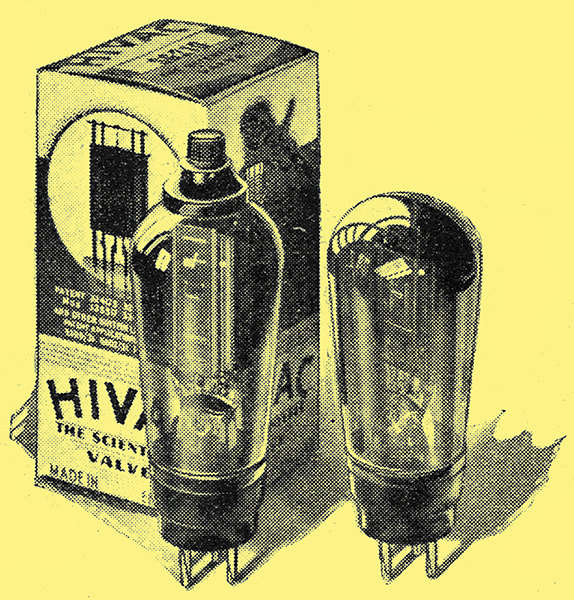|

Selection of Hivac two-volt valves.
Hivac valves are made by The High Vacuum Valve Co., Ltd., 113/117, Farringdon Road, London, EC, attention having been given so far to the development of the two-volt battery valves. Other types are in course of development, and will soon make their appearance. In all, eleven different battery types are contemplated, but at the time of preparing this review seven only are generally available, but the remainder will be released very soon. The seven two-volt battery valves examined comprise an H210, L2I0, D210, P220, PP220, SG2I0 and VS210. The last two mentioned are screen-grid HF amplifying valves, the VS210 being a variable-μ type. The working grid bias is from 0 to 14 Volts and over this range the mutual conductance changes from 1 mA/Volt to 0.075 mA/Volt. The maximum anode potential is 150 Volts, and the price of this valve and the ordinary screen-grid model is 10s. 6d.
The D210 is a triode valve designed especially for use as a detector. It differs from the other general-purpose types in that the entire electrode assembly is surrounded by an earthed shield, the function of which is to reduce the external electrostatic field of the valve. The D2I0 has an AC resistance of 13,300 Ω, an amplification factor of 16 and a mutual conductance of 1.2. Its price is 5s. 6d.
The H210 and the L2I0 are general purpose valves, the former being suitable for use as a grid detector or oscillator in superheterodyne receivers while the latter will serve as a first stage LF amplifier or anode bend detector. The H210 has an AC resistance of 22,000 Ω and an amplification factor of 25, while the L210 is rated at 8,600 Ω AC resistance and amplification factor 10, and the price is 4s. 6d. in each case.
Two power valves are available, a P220 and a PP220, the former costs 5s. 6d. and the latter 6s. 6d. The P220 is intended primarily for use in portable sets and provides an undistorted output of I75 milliWatts, while the PP.22o gives about 250 milliWatts. Pentode equivalents and also a Class B amplifier will be available very soon.
Tests made with some specimen Hivac valves in a recent Wireless World receiver gave results in every respect comparable with those they replaced, selectivity, sensitivity and volume being sensibly the same and the performance of the receiver was entirely satisfactory from every point of view. When the remaining valves in this series become available there will be an exact replacement for every valve now in general use.
|